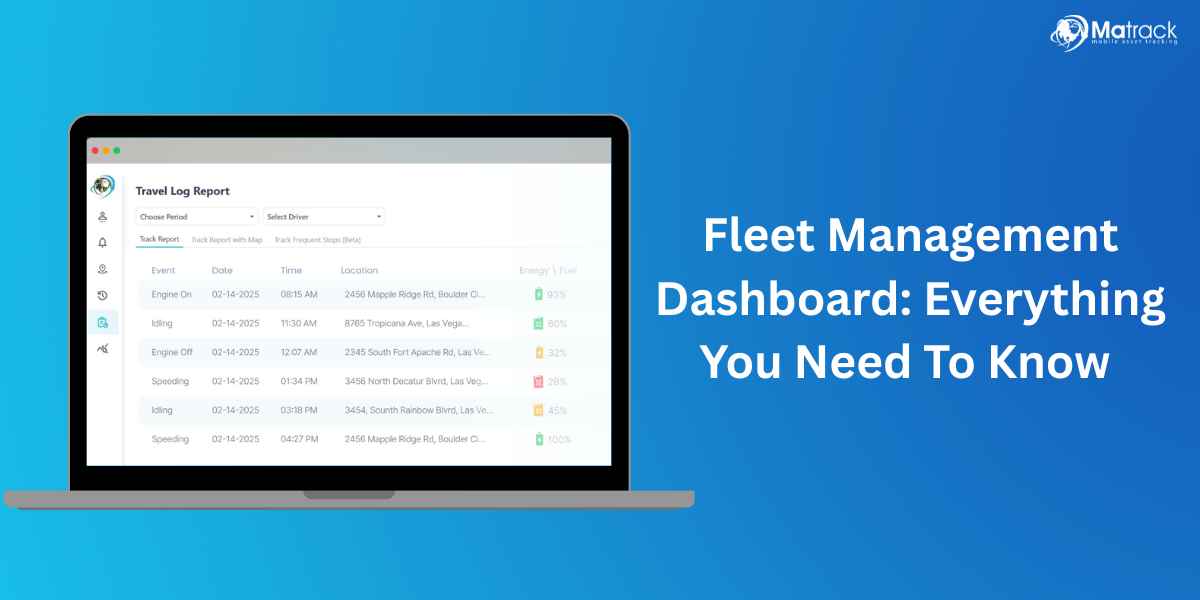Key Takeaways:
- Fleet Management Dashboard centralizes GPS, fuel, maintenance, and driver data into one real-time interface.
- It converts raw inputs into visual formats that simplify tracking, performance monitoring, and issue detection.
- Setting up the system involves installing telematics, integrating data sources, configuring metrics, and training users.
- Monitoring KPIs like fuel efficiency, driver behavior, and route accuracy improves decision-making and operational control.
What Is A Fleet Management Dashboard?
Fleet Management Dashboard is a centralized interface that connects telematics, vehicle data, GPS tracking, fuel reports, and maintenance logs. It brings every fleet operation into one clear, accessible view.
The system turns detailed inputs into visual formats like maps, charts, and tables. This helps managers track vehicles, spot issues, and monitor performance in real time.
Its focused layout removes clutter and highlights the most important data. This allows quick action based on accurate and timely insights.
Key Features Of A Fleet Management Dashboard
GPS Tracking
GPS tracking shows the exact location, speed, and route history of every vehicle in real time. It enables immediate response to delays, route deviations, or emergencies.
Driver Behavior Monitoring
Driver behavior monitoring records actions like harsh braking, rapid acceleration, and sharp turns. It helps identify risky driving patterns that impact safety and fuel efficiency.
Fuel Management
Fuel management tracks consumption rates, refill logs, and potential theft. It highlights inefficiencies and supports better control of operating costs.
Maintenance Alerts
Maintenance alerts are triggered by mileage, engine hours, or time intervals. These alerts prevent unexpected breakdowns and reduce unplanned downtime.
Route Optimization
Route optimization analyzes traffic, distance, and delivery windows to suggest the most efficient path. It cuts fuel use and improves delivery timelines.
Compliance Tracking
Compliance tracking captures driver logs, HOS data, and inspection records. It ensures the fleet meets transportation regulations without manual oversight.
Custom Reports
Custom reports convert raw fleet data into downloadable summaries. These reports support audits, performance reviews, and data-driven decisions.
What Are The Types Of Fleet Management Dashboards?
Operational Dashboards
Operational dashboards display real-time vehicle location, speed, and operational status. These dashboards support immediate decision-making during daily fleet activities.
Tactical Dashboards
Tactical dashboards compare driver performance, route efficiency, and delivery costs. They help managers evaluate productivity and adjust strategies based on trends.
Compliance Dashboards
Compliance dashboards organize HOS records, inspection histories, and audit logs. These tools ensure alignment with transport laws and reduce legal risks.
Maintenance Dashboards
Maintenance dashboards track part replacements, service history, and upcoming maintenance tasks. They help prevent breakdowns and extend vehicle lifespan.
Fuel Dashboards
Fuel dashboards provide insights into refueling points, mileage efficiency, and fuel expenses. These views identify cost-saving opportunities and detect anomalies like fuel theft.
How To Set Up A Fleet Management Dashboard?
Install Telematics Devices
Begin by installing a telematics system in each vehicle to capture GPS location, engine performance, and diagnostic data. This creates the foundation for real-time tracking and analytics.
Integrate Systems
Connect the dashboard to related systems like fuel cards, electronic logging devices (ELDs), HR databases, and maintenance logs. Integration ensures all fleet data flows into one platform.
Configure Metrics
Set thresholds for key performance indicators such as speeding, idle time, and fuel consumption. These configurations trigger alerts and drive performance monitoring.
Train Users
Provide training sessions and tutorials to help managers and drivers understand alerts, interpret dashboard data, and respond effectively. User adoption depends on clear understanding.
Activate Reports
Set up automated reports on a daily, weekly, or monthly basis. These reports help track trends, evaluate performance, and support strategic decisions.
How To Monitor Fleet Management Dashboard KPIs?
Track Real-Time Metrics
Monitor real-time metrics like vehicle speed, engine status, and current location through the live dashboard view. This ensures instant visibility into active operations.
Review Driver Behavior Scores
Use driver scorecards to evaluate performance based on speeding, idling, hard braking, and harsh acceleration. These KPIs highlight safety risks and training needs.
Measure Fuel Efficiency
Check fuel consumption data, refueling patterns, and MPG statistics regularly. Monitoring these KPIs helps detect fuel waste and reduce operational costs.
Analyze Maintenance Logs
Monitor service intervals, repair frequency, and part replacements. Consistent tracking of maintenance KPIs prevents breakdowns and prolongs vehicle health.
Evaluate Route Performance
Compare planned routes with actual travel paths and delivery times. Route efficiency KPIs help reduce delays, fuel use, and unnecessary mileage.
Monitor Compliance Status
Track hours-of-service logs, inspection records, and ELD alerts. Compliance KPIs ensure the fleet meets legal requirements without manual checks.
Generate Performance Reports
Review automated reports for trends across all KPIs. These summaries reveal patterns and support long-term improvements in fleet strategy.
Related: Fleet Performance Management KPIs
What Are The Benefits And Challenges Of Fleet Management Dashboards?
| Benefits | Challenges |
| Reduces fuel and repair costs | Too many metrics reduce focus |
| Improves driver behavior | Drivers resist constant monitoring |
| Enables instant decision-making | Complex interfaces slow usage |
| Ensures legal compliance | Sensor errors disrupt accuracy |
| Increases asset utilization |


